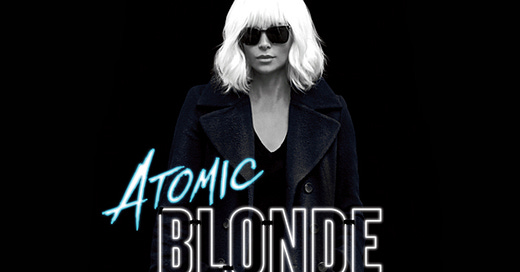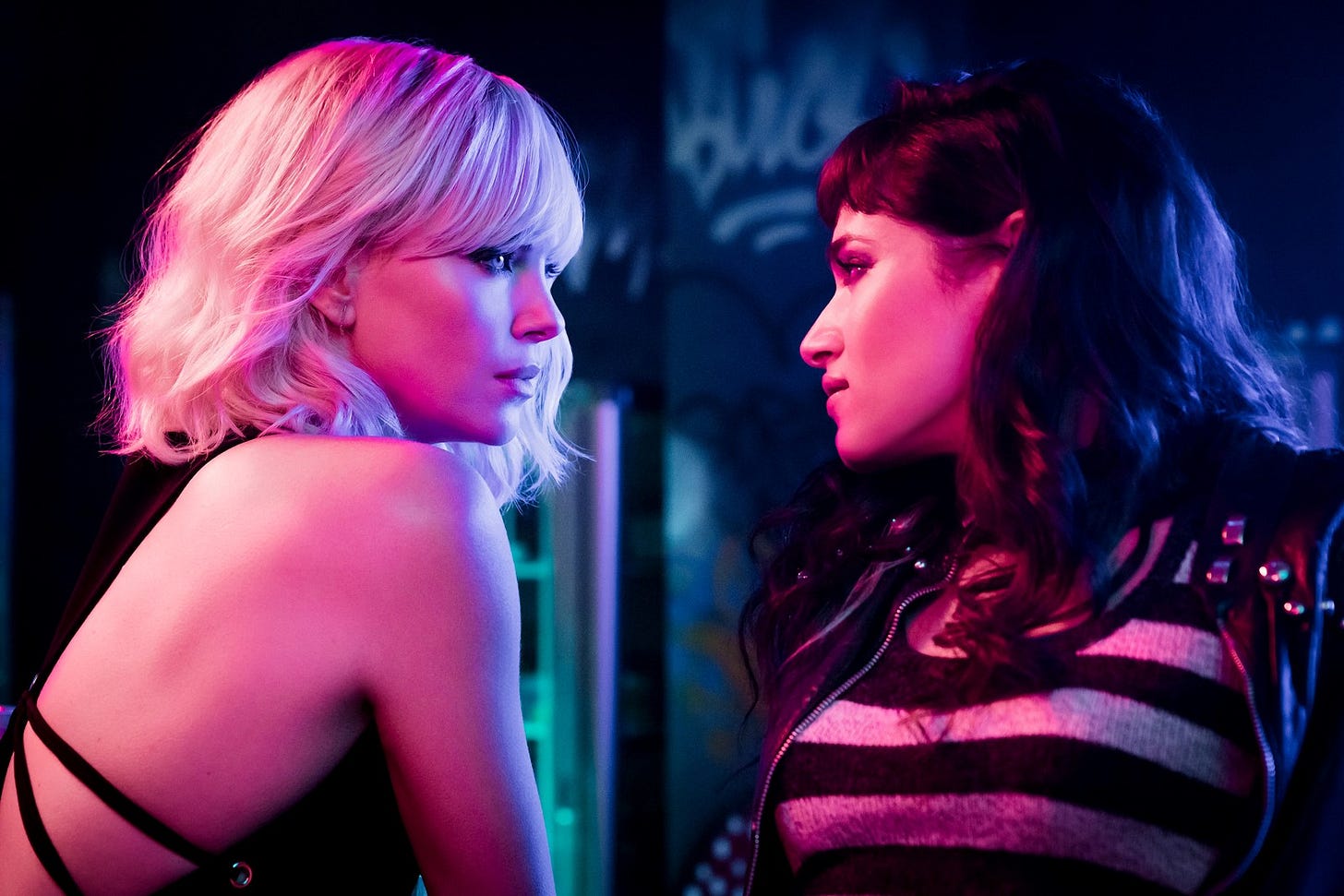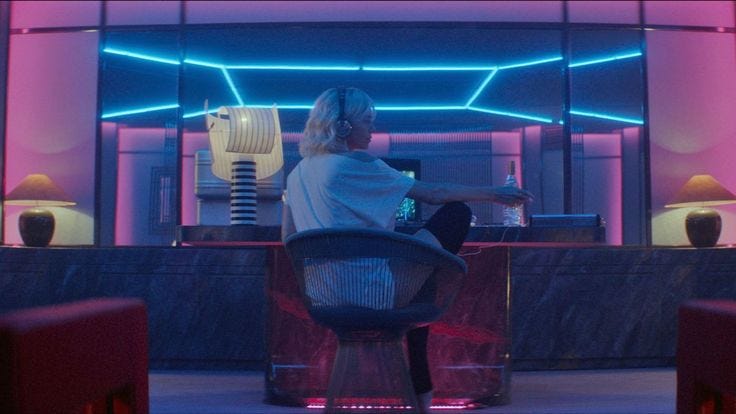It’s November 1989 in London. British spy Lorraine Broughton (Charlize Theron) stands in her hotel bathroom, her body of bruises bathed in a neon blue light as she sets fire to a photo of her former lover - another spy whose death she had been sent to Berlin to investigate. As David Bowie’s Cat People fades in, she wraps herself in a white trench coat, lights a cigarette and struts through the cold streets to be interrogated about her mission. Critical opinions are divided on whether the plot divulged in that interrogation makes any sense, but there is one thing everyone seems to agree on - this movie is so damn cool.
This essay contains light spoilers around the relationships in the film, but no plot spoilers.
Film Details
Director: David Leitch
Writer: Kurt Johnstad (based on the graphic novel written by Antony Johnston and illustrated by Sam Hart)
Stars: Charlize Theron, James McAvoy
Genres: Thriller, Adventure, Action
Theatrical Release Date: July 2017 (USA)
Country and Language: USA, English
Running time: 1hr 55min
Setting the scene
There are a series of important events that needed to happen to give us Atomic Blonde in 2017.
In the early 2010s, writer Antony Johnston needed to come up with the premise as a graphic novel.
In 2014 we needed John Wick (Chad Stahelski) to take the world by storm, showing slickly choreographed fight scenes could hold up a movie in their own right.
In 2015, Charlize Theron needed to steal the show in Mad Max: Fury Road (George Miller), showing a female lead can kick ass and make bank at the box office. Then, in 2017, Wonder Woman (Patty Jenkins) would need to be released to show a female lead can kick ass and make bank at the box office, because Hollywood does seem to forget that lesson every time1.
All of these elements then needed to come together, with John Wick co-director David Leitch collaborating with Charlize Theron (whose production company owned the rights to the graphic novel) on another female-driven action film that would come out in the wake of the Wonder Woman hype. And somehow, this did happen, giving the world a film soaking in 80s nostalgia, with a collapsing Berlin Wall backdrop and a bisexual, female lead that beat The Emoji Movie (Tony Leondis) to number 1 at the box office on opening weekend2.
From The Coldest (Straight) City to the Atomic (Bi) Blonde
There are very few queer action heroes, and even fewer who are given a lead role. I give props to Valkyrie and Loki in the Thor franchise. Deadpool is bi, but the comedic way this is addressed in film adaptations is hit and miss, sometimes feeling more like schoolyard gay jokes3. And anyway, almost all these instalments came after Atomic Blonde fly-kicked through the hetero action glass ceiling.
Atomic Blonde is a true all-rounder. Lorraine’s bisexuality is an embedded part of her character, and while queer representation should not just be measured by characters kissing or having sex in a film, Atomic Blonde also hits that mark too. This, however, was not always the case. The Lorraine Broughton in the graphic novel The Coldest City is not bisexual. In fact, this visually minimalist source material has very little symmetry with Atomic Blonde outside of the core plot. This was something Theron brought to the table as executive producer:
“She was never kind of bisexual or anything like that [in the novel] and that to me was just like, why not? I mean, come on.”4
While Lorraine is investigating the death of her male lover in Berlin, she becomes entangled with French spy Delphine (Sofia Boutella). Her sexuality isn’t explained or challenged or made fuss of, again driven by Theron and her position on how she feels she can assist with queer representation:
“I feel like the thing that maybe I could bring to the table in moving all of this stuff forward is to just make sure that the stories that I tell and the characters that I play reflect the world…in a way where we're not asking a million questions around it5. This is just how it should be.”6
While there is a potential to read some of the bi representation as falling into harmful stereotypes, namely Lorraine’s duplicity as a spy feeding into stigma around bi people being deceptive and manipulative, I think these would be narrow readings of the surface-level representation rather than reflecting how sexuality actually relates to characterisation here. The film never goes for the spy trope of sleeping with someone to get information out of them7, and subverts the viewers expectations by never letting the barbed exchanges between Lorraine and her Berlin contact David Percival (James McAvoy) heat up into a sexual affair. She is deceptive by nature of being a spy, but her bisexuality isn’t depicted as an extension of that. Instead, her romantic entanglements are moments of honesty in her character and the only times we really glimpse a level of humanity in Lorraine under her tough exterior.
But not only does Atomic Blonde give us an unquestioned, open, bi character, it also makes her unfathomably cool.
Kicking Ass and Looking Cool
“A sleazy, neon aesthetic that looks like an X-rated, ultraviolent knock-off of a Duran Duran video”
Most people resolutely agree that this movie looks and feels cool as fuck. While some critics have accused it of ‘style over substance’, that seems to have been almost intentional. As director David Leitch highlights in film commentary:
“One of the directives from the beginning was cool overrides everything.”
And from visuals to stunts to soundtrack, that directive is achieved in spades.
The stand-out element of the film is the expertly choreographed fight scenes Theron punches and kicks her way through over the film’s run time. Reviews of Atomic Blonde are consistently in awe of the ten-minute fight sequence8 inspired by the action oner in Children of Men (Alfonso Cuarón, 2006), with Theron (doing all her own stunts) battling her way down an apartment building, taking out enemies on each floor. The shots are intimate and flow with the action, with every punch and fall connected to a bruise we are shown on Lorraine in the opening scene of the film. Like in John Wick, inspiration was also taken from shooting styles of Hong Kong action movies:
“We pick one camera and that camera is set in the most specific place that works for the three or four moves that we want to capture. And then we change the perspective. You’re almost shooting in continuity, and you’re clipping the sequence together. And so each camera angle has a really specific purpose.”9
The film also utilises a number of 80s needle drops to punctuate the scenes, from Nena’s 99 Luftballons to London Calling by the Clash to Lorraine blaring George Michael’s Father Figure through a stereo to cover up the sound of her taking down multiple police officers in a Berlin flat. The music is embedded into the pace of the film, as Leitch played the songs on set for some scenes to help actors walk in time with the beat10.
Then there are the visuals. The film has been dubbed a ‘neon-noir’ for a reason, and there is rarely a scene that isn’t saturated in artificial lighting. Every shot of Theron in her Berlin hotel room features pink, purple and blue lighting to the extent that you question whether she can actually turn them off. While many fans of the bisexual lighting craze saw these colours as a form of intentional bi representation, the commentary indicates again that the lighting was picked mainly because it looked really cool.
This focus on style gives us something very unique. While Lorraine Broughton has been compared to James Bond, John Wick and Jason Bourne, putting this character in an idiosyncratically styled film helps elevate this female spy hero above the claims of being ‘a female Bond’ or something similar. She is her own hero in her own time in her own style, giving it a unique viewing edge since you can’t get what this film gives you in any of those other franchises11.
“There is a misconception sometimes when we talk about women in this genre that they wanna be guys or that they want to fight like guys, and that’s not really the point. The point is that we utilise who we are in that genre really well.”
Final thoughts
This movie feels really cool to watch, and sometimes that’s good enough for me. The commentary reveals some genuine issues in the plotting, with large amounts of dialogue being cut but hefty amounts of ADR12 still being needed to patch up holes and tie up loose ends. But Leitch and editor Elísabet Ronaldsdóttir13 don’t linger on this in commentary or discuss much about the ins and outs of the narrative. They are confident there is enough there to hold the story together and instead focus most of their discussion on the style, which feels like the right choice. In some ways it could be argued this even strengthens the quality of the bi representation, with the lack of focus on the narrative allowing it to sit naturally within the story rather than be overworked in dialogue.
I am a big believer in meeting films where they are, and we can’t evenly compare all films by the same standards across the board or even within the genres they inhabit. If you go into Atomic Blonde expecting it to be a dark John le Carré spy thriller or as slick as James Bond, you will be disappointed because it’s not trying to be those things. If you go in knowing their guiding principle was ‘cool overrides everything’, I think you will have a good time. Give yourself permission to let go of the plot and soak in that 80s, neon, spy energy led by a cool, bi hero.
Let’s do this together
I would love to get your comments and insights on my work so we can grow this place together. Please like and share and comment and all that other stuff. It’s much appreciated.
In the words of Charlize Theron: “We’ve had moments like this, where women really showcase themselves and kind of break glass ceilings. And then we don’t sustain it. Or there’s one movie that doesn’t do well, and all of a sudden, no one wants to make a female-driven film.” (2017 Variety interview)
Welch, Alex. “Atomic Blonde Beats Emoji Movie At Box Office.” ScreenRant, 28 July 2017, .
It is worth noting that David Leitch did direct Deadpool 2 (2018) as well as Atomic Blonde, but did not write either film.
Charlize Theron, quoted in Azzopardi, Chris. “Charlize Theron Talks Queerness In Her Films, Being Woefully Straight & Getting Her Daughter’s Pronouns Right.” Pride Source, 17 Dec. 2019.
And while there weren’t a million questions about Atomic Blonde’s bisexuality when the film was released, there was at least one about Theron’s. Media buzz spread following an interview with Andy Cohen when she was asked if she had ever ‘swum in the lady pond’. Theron expressed she experimented in her young years, “but it was clear that I really liked dudes”. The question seemed to be easy to shrug off and move past, as much as outlets seemed to like using the term ‘lady pond’ in headlines.
Charlize Theron, quoted in Azzopardi, Chris. “Charlize Theron Talks Queerness In Her Films, Being Woefully Straight & Getting Her Daughter’s Pronouns Right.”
She does tell her superiors that she slept with Delphine to get information, but this is clearly a lie meant to protect the true emotional vulnerability of the relationship.
It is often referred to as a ‘single take’ fight sequence, but is in fact about 40 shots expertly spliced together. The commentary was a great breakdown of the different places cuts happened, often in a motion blur when a camera turns or when a body obscures the lens.
David Leitch quoted in Murphy, Mekado. “Anatomy of a Scene: David Leitch Narrates a Scene From ‘Atomic Blonde.’” New York Times, 2017.
Director commentary for Atomic Blonde (2017).
For more on this, I recommend Anne Cohen’s piece in Refinery29 ‘Why Atomic Blonde Proves We Don't Need A Female Bond’
Additional Dialogue Recording. This is dialogue recorded or re-recorded after a film is shot to fill in blanks or fix problems that might have occurred in sound recording on set.







